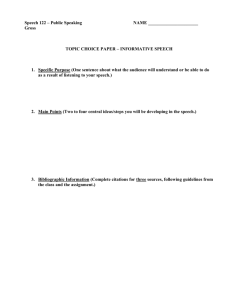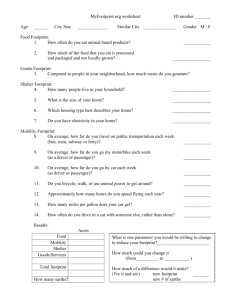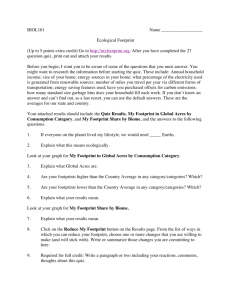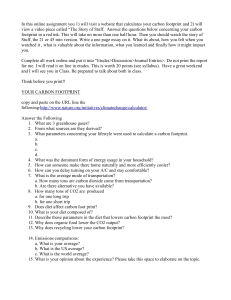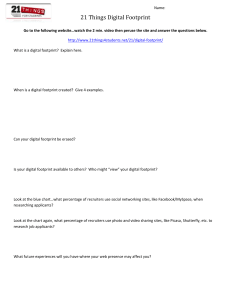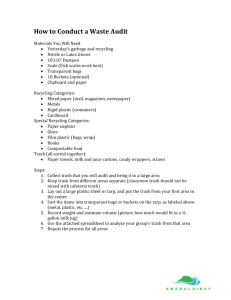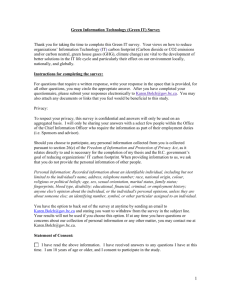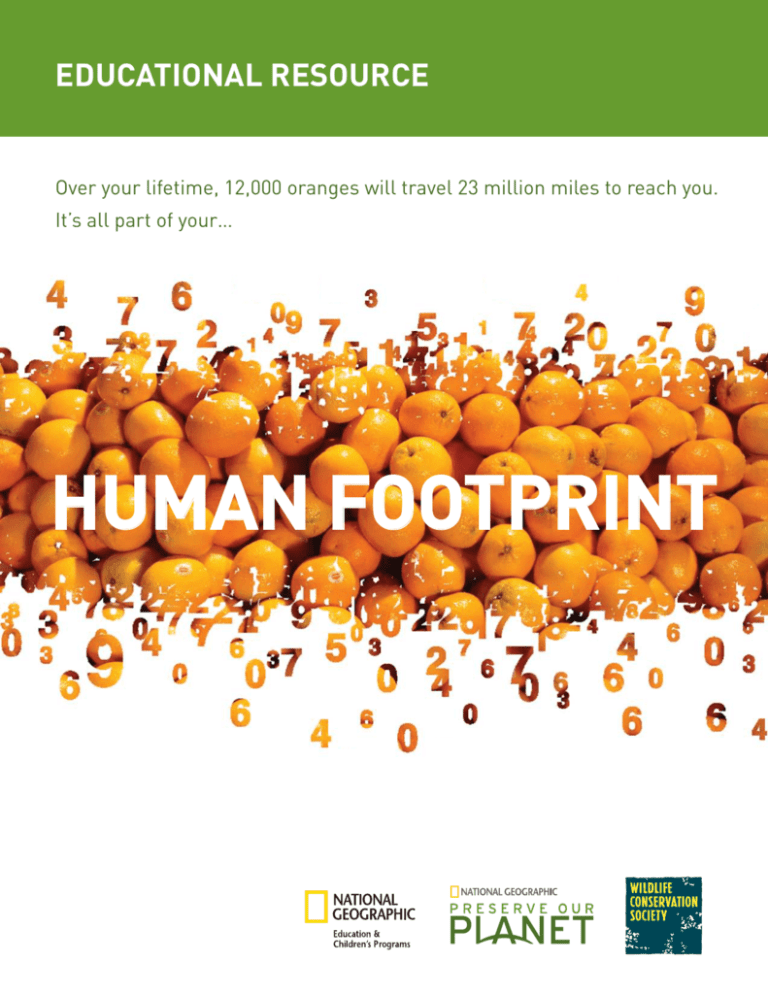
Educational Resource
Over your lifetime, 12,000 oranges will travel 23 million miles to reach you.
It’s all part of your…
HUMAN FOOTPRINT
2
Introduction
Think about what you use, consume, and discard
in an average lifetime. Calculate this for every
American and then for every person on Earth.
Humans have left their mark on 83 percent of
Earth’s surface. What can we do to reduce our
environmental impact?
What’s Inside:
This companion to National
Geographic Channel’s Human
Footprint includes background
information, a lesson plan, and
three activities:
“Human influence on Earth can be positive or
negative, benign or catastrophic. Recognizing this
responsibility is the first step each of us can take to
transform the human footprint and save the last
of the wild.”
• Mapping Our Human Footprint
• Perils of Plastic
• Protecting Earth’s Wildlife
– Dr. Eric W. Sanderson
Director, Human Footprint Project
Wildlife Conservation Society/Columbia University
Over an average lifetime, each American will…
Note: Calculations based on an average lifetime of 77.75 years or 28,379 days. The United States population is rounded to 301,000,000.
Read 5,054 newspapers
= 43 trees
Discard 64 tons
of garbage
Use 1.8 million
gallons of water
Photographs ©iStockphoto.
com/Scott Vickers;
©iStockphoto.com/Christine
Balderas; ©iStockphoto.com/
Mike Clarke; ©iStockphoto.
com/Aliaksandr Autayeu
HUMan FOOTPRINT
nationalgeographic.com/preserve-our-planet
© 2008 National Geographic Society; Educators may reproduce for students.
Burn 31,350 gallons
of gasoline
3
warm up
Review and discuss with students.
Humans have influenced 83% of Earth’s surface.
>
This finding from the Human Footprint Project, a major initiative of the Bronx
Zoo-based Wildlife Conservation Society, is based on analysis of four factors
that have the most impact on wildlife and wild lands: population, travel routes,
land use, and lights.
Discuss: Does this number seem like
a lot or a little? Some areas are more
vulnerable to human influence than
others—why might this be?
Possible answers: Answers will vary,
but remind students that 83% is just over
4/5’s of Earth’s surface. Areas that are
highly vulnerable are those that are easily
accessible to humans and/or those that
can supply natural resources that are
in demand.
Human Footprint
Atlas: North America
Human Footprint Atlas:
World
Our footprint varies around the world.
Americans make up five percent of the world’s population, own 30 percent of
the world’s cars, and consume 25 percent of the world’s energy. By their first
birthday, the average American will be responsible for more carbon dioxide
emissions than a person in Tanzania generates in a lifetime.
>
Discuss: Why do different cultures use
and consume things at different rates?
What do these numbers indicate about
contemporary American culture?
Possible answers: Answers will vary,
but encourage students to make a
connection to variables such as average
lifespan; income; access to goods; diet;
culture; climate.
Illustrations © Wildlife Conservation Society
HUMan FOOTPRINT
nationalgeographic.com/preserve-our-planet
© 2008 National Geographic Society; Educators may reproduce for students.
Go to wcs.org/humanfootprintatlas to download maps.
4
Global population trends impact our footprint.
Today’s global population (estimated at 6.6 billion) is expected to rise to nine
billion by 2050 and to over 36 billion by 2300.
Estimated
over 36 billion
by 2300
Global population trend
In some areas of the globe,
> Discuss:
people are already in conflict over a
limited amount of natural resources.
How will a growing population affect
people’s access to food, potable
water, and fuel? What affect might the
population increase have on pollution
and encroachment on wildlife habitats?
Possible answers: A rise in population
will increase demands on food, water and
fuel; pollution and habitat loss will also
likely increase unless steps are taken to
offset the rise in global population.
Estimated 9 billion
by 2050
Less than
1 billion
in 1800
Credits
This companion to Human Footprint was produced by
National Geographic Education & Children’s Programs.
© 2008 National Geographic Society. All Rights Reserved.
Educators may reproduce for students.
Special thanks to:
NATIONAL GEOGRAPHIC Kevin Allen, Dierdre BevingtonAtardi, Glenn C. Caillouet, Meredith Conte, Mary Crooks,
Mary Dunnington, Stephanie Gaspers, C. Trieste Lockwood,
Alice Manning, James McClelland, Patricia Norris
National Geographic
Wildlife Conservation Society
Earth Pulse
Human Footprint Project
nationalgeographic.com/earthpulse
wcs.org/humanfootprint
Human Footprint
Human Footprint Atlas
nghumanfootprint.com
wcs.org/humanfootprintatlas
Preserve Our Planet
U.S. Census Bureau
TRANSGROUP WORLDWIDE LOGISTICS Shan Hoel
preserveourplanet.com
U.S. and World Population Clocks
WILDLIFE CONSERVATION SOCIETY Natalie Cash, Sarah
Hobel, Kimio Honda, Jennell Ives, Robert Rose, Eric W.
Sanderson, Ph.D
census.gov/main/www/popclock.
html
ADVENTURE ECOLOGY Ela Stevenson
ALGALITA MARINE RESEARCH FOUNDATION Marieta
Francis, Captain Charles Moore
FOREST STEWARDSHIP COUNCIL Katie Miller
Content Development: Audrey Carangelo, Writer; Amy
Grossman, Editor
Design: Project Design Company—Daniel Banks,
Art Director; Kerri Sarembock, Designer
Images: Cover: Photo by National Geographic Channel
© 2008 Fox Cable Networks Services, LLC. All rights
reserved.
Damascus, Syria by James L. Stanfield/National Graphic Society; Illustration by C. Trieste Lockwood; Population data:
World Population Prospects: 2000 Revision, United Nations Population Division, Department of Economic and Social Affairs
HUMan FOOTPRINT
National Geographic Channel and the Yellow Border
are trademarks of National Geographic Society, used
with permission.
nationalgeographic.com/preserve-our-planet
© 2008 National Geographic Society; Educators may reproduce for students.
online resources
5
activity 1: Mapping Our Human Footprint
Students learn about the Human Footprint Atlas, analyze
a map showing where and to what extent humans have
influenced Earth, and participate in a class discussion. They
make connections between patterns of human influence and
geographic factors.
directions
1. I ntroduce. Scientists with the Wildlife Conservation
Society/Columbia University’s Human Footprint
Project mapped degrees of human influence over
every square kilometer of Earth’s surface (1 square
kilometer = .39 square mile).
• Four factors were evaluated—population, travel
routes, land use, and lights. While humans affect
Earth in many ways, these four have the most
immediate impact on wildlife and wild lands.
2. D
isplay Human Footprint Atlas: World map. Review
the legend, explain that green signifies areas of
lesser human influence; red signifies areas of greater
human influence:
Materials:
•W
orld map from the Human
Footprint Atlas: World
(wcs.org/humanfootprintatlas)
•A
dditional country or regional
map(s) from the Human
Footprint Atlas (optional)
•O
verhead or computer
projector to display map(s)
•2
0-30 minutes for class
discussion
use, and lights)? Which factors are likely to change
over time? Each factor could increase, decrease, or
remain unchanged over time. The Human Footprint
Atlas will need to be constantly updated to reflect
these changes.
• In which areas is the degree of human influence
greater (shaded red)? Possible answers: Europe,
India, Southeast Asia, and the eastern coast of
South America.
• What connections can students make between areas
of greater influence (shaded red) and geographic
factors (e.g., climate, physical landscape). Encourage
students to notice that these areas tend to have
a moderate climate, arable land, and proximity to
oceans. They are also close to sources of fresh water
and are easily accessible.
Discussion prompts:
• What areas are less influenced by humans (shaded
green)? Possible answers: the Amazon Rainforest, the
Sahara Desert, Northern Canada, Northern Russia,
and central Australia.
• What connections can students make between areas
of less influence (shaded green) and geographic
factors (e.g., climate, physical landscape). Encourage
students to notice that these areas tend to have a
harsh climate and are remote and/or inaccessible due
to physical features (e.g. Arctic Circle, Sahara Desert,
the Himalayas, the Amazon rainforest).
• Will areas with lower degrees of human influence
remain this way (remind students that this map
reflects four factors: population, travel routes, land
For Further Discussion
• This map does not show population, but
areas that have been affected by human
populations. Have students compare this map
to a world population map. What differences
do they see?
• Have students compare two continents and
hypothesize reasons for different levels of
human influence.
• Have students compare one or more regional or
country maps from the Human Footprint Atlas.
• Ask students to visualize (or draw) a map
of human influence of their hometown.
What gradient or color is their school
neighborhood? The nearest park? The
nearest shopping area?
Illustration © Wildlife Conservation Society
HUMan FOOTPRINT
nationalgeographic.com/preserve-our-planet
© 2008 National Geographic Society; Educators may reproduce for students.
• Find your hometown. What color is it on the map?
How great is the human influence? Answers will vary.
6
activity 2: Perils of Plastic
Materials:
• Perils of Plastic (PDF)
Students learn about the world’s largest “landfill”, a collection
of trash covering an estimated five million square miles of the
Pacific Ocean. To connect this crisis to their own world students
collect their recyclable trash for one week and weigh it. They
extrapolate this number to make additional calculations.
•P
aper bags, garbage cans or
cardboard boxes to collect
trash, bathroom scale, labels
•2
0-30 minutes to read
and discuss handout, and
introduce activity; One
week for students to collect
recyclable trash; 30-45
minutes to complete activity
directions
away nearly 15 tons of packaging. Much of this
ends up in the oceans, and much of it is plastic. As
plastic ages it breaks into pieces (called “nurdles” or
“mermaid tears”). These pieces make their way into
the food chain and can sicken or kill wildlife.
2. D
istribute Perils of Plastic student handout.
3. R
ead and discuss. What is the so-called “Great
Pacific Garbage Patch”? (The world’s largest
trash “landfill”, located in the Pacific Ocean.) What
factors combine to form this massive collection of
garbage? (The garbage collects in the ocean due to
a combination of human and environmental factors.
A system of ocean currents called the North Pacific
Subtropical Gyre collects and traps trash, mostly from
the shores of America and Asia.) What is so daring
about David de Rothschild’s voyage? (He plans to sail
8,000 miles across the Pacific Ocean in a lightweight
raft made from plastic bottles.)
4. S
tart activity. Tell students that they are going to
collect their recyclable trash for a week.
• Students should bring in “clean” trash only.
Bottles and cans should be rinsed and dried.
All paper, plastic, and metals should be clean.
• Option: students can collect all of their recyclable
trash or trash from lunch only, from school only,
from home only, etc.
5. W
eigh and Calculate. After one week, have students
measure and weigh the accumulated trash. Then ask
students to calculate:
HUMan FOOTPRINT
• If this is the amount of trash from one week,
what would it equal at the end of one year?
After ten years?
• Factors such as collecting recyclable trash from
lunch only should be taken into account when
making subsequent calculations.
6. S
hare and Reflect. Ask students to share what they
learned from the reading and activity.
• Why is plastic harmful to the environment?
• Why could people do to produce less trash?
Assessment
Rate students on a scale of one to five based
on the following components:
• Read and understood the information in
Perils of Plastic.
• Participated in a classroom discussion about
plastic trash and the Plastiki voyage.
• Contributed clean, recyclable trash to the
class collection.
• Participated in the “weigh-in” of collected
trash.
• Extrapolated one week’s worth of recyclable
trash to a year and ten years.
• Made a connection about personal
consumption and how the waste each of us
generates can have a negative impact on the
environment.
nationalgeographic.com/preserve-our-planet
© 2008 National Geographic Society; Educators may reproduce for students.
1. I ntroduce. Over a lifetime, each American throws
7
activity 3: Protecting Earth’s Wildlife
Students learn how a growing demand for natural resources
such as wood and coltan threatens habitats and wildlife. They
select one issue and develop a list of actions people could take
to reduce or reverse the problem. They complete a project (e.g.,
poster, skit, graphic novel) communicating the issue and their
action steps.
Materials:
•P
rotecting Earth’s Wildlife
student handout (PDF)
•O
ne-two class periods to
complete activity, additional
time to share and review
directions
1. I ntroduce. Explain that around Earth, wild habitats
2. D
ivide the class into small groups. Distribute
Protecting Earth’s Wildlife to each group.
3. E
xplain. Tell students they have been given a fact
sheet about two animals whose habitats and futures
are under threat. Ask students to:
Step 1: Read. Review the handout and select one
animal to focus on.
Step 2: Summarize. Use a separate piece of paper
to note key issues.
Step 3: Brainstorm. Create an action list of steps
people could take to reduce or reverse the problem.
Step 4: Create. Share the issue and suggest action
steps. Create a poster, storyboard, PSA, graphic
novel, skit—or another idea they propose—that
communicates the key issues and suggested
action steps.
Assessment
Rate students on a scale of one to five based
on the following components:
• Read and understood the information in the
student handout about the growing demand
for natural resources and the impact this
demand has on habitats and wildlife.
• Worked in a group to select one animal and
habitat on which to focus.
• Summarized key issues that the animal and
its habitat face.
• Brainstormed with the group to create a list
of actions people could take to reduce or
reverse the problem.
• Developed and completed a presentation
such as a skit, poster, or pamphlet, that
communicated key issues and suggested
actions people could take to reduce or
reverse the problem.
© 2008 National Geographic Society; Educators may reproduce for students.
and the wildlife they support are threatened because
of human activity. Only 17 percent of Earth’s surface
remains untouched by human influence.
4. S
hare and review. Encourage students to present
their completed activities to the rest of the class.
You may want to have a Human Footprint day when
students come together to share their findings.
You can also create a Human Footprint area in your
classroom and display the students’ final projects.
HUMan FOOTPRINT
nationalgeographic.com/preserve-our-planet
Perils of Plastic
Name: The world’s largest trash “landfill” isn’t on land—it’s in the
Pacific Ocean.
The so-called “Great Pacific Garbage Patch” covers an
estimated five million square miles of ocean waters.
That’s the size of the United States, Mexico, and Central
America combined!
Preserving the planet is important. That’s
why David de Rothschild, a National
Geographic Visiting Fellow, is leading a
dangerous voyage through this very spot.
ASIA
NORTH
AMERICA
Hawai‘i
P A C I F I C
O C E A N
N
AUSTRALIA
His goal is to sail from the United States to Australia
on the Plastiki, a raft made from plastic bottles. Along
the way, he’ll report on eco-issues. “Saving the planet,”
says David, “is going to be one of this century’s greatest
adventures.”
Attempting to sail 8,000 miles on a plastic raft will be next
to impossible. For David, that’s the point. He pushes his
limits in order to inspire people to challenge and rethink
their own.
Did You Know?
• Americans throw out 694 plastic
bottles per second. That’s 60
million a day!
• Over time, plastic becomes brittle
and breaks apart into tiny pellets called “nurdles” or “mermaid
tears.” Wildlife that eat the pellets
can sicken or die.
• Some parts of the Pacific Ocean
contain six parts of plastic to one
part of plankton!
Map © National Geographic Society Maps; ©iStockphoto.com/Dóri O’Connell
HUMan FOOTPRINT
nationalgeographic.com/preserve-our-planet
© 2008 National Geographic Society; Educators may reproduce for students.
The trash is carried—and trapped—by a
system of surface currents called the North
Pacific Subtropical Gyre. A whopping 80
percent of the trash is plastic, carried from
the shores of Asia and the Americas.
WORLD’S LARGEST
TRASH “LANDFILL”
Protecting Earth’s Wildlife
Name: directions
Step 1: Read. Learn about threats to Western lowland gorillas and Okapi, and select one animal to focus on.
Step 2: Summarize. Use a separate piece of paper to note key issues.
Step 3: B
rainstorm. What actions could people take to reduce or reverse the problem?
Forests in the Republic of Congo are mined for lumber. The Western lowland
gorilla depends on a forest habitat for survival.
Rare and shy, okapi are known to live in just one place on Earth, the
Democratic Republic of the Congo. Demand for coltan, a valuable mineral,
is changing their habitat.
Under Threat: Western Lowland Gorillas
Under Threat: Okapi
The Ndoki-Likouala Landscape, in the Republic of Congo,
supports many species including the Western lowland
gorilla. This area’s rich biodiversity is under threat because the trees are being cut down—often illegally—to
provide wood used to build houses in the United States.
The Ituri Forest in the Democratic Republic of the Congo
is home to the okapi (pronounced oh-’KAH-pē), a rare
mammal that is related to the giraffe. The Congo also
contains 80 percent of the world’s known reserves
of coltan. This black, tar-like mineral is mined and
processed into a heat-resistant powder that is in global
demand. Why? It’s used in things like laptop computers,
digital cameras, game consoles, cell phones—and many
other products.
Two million homes are built in the United States each year
and an average house uses wood from 64 trees. American
houses are doubling and tripling in size, so more lumber
is needed. Some of this lumber is coming from places like
the Ndoki-Likouala Landscape.
Efforts are underway to protect
this region’s wildlife and habitat.
For example, companies that
follow strict environmental and
social standards can use a Forest
Stewardship Council (FSC) logo on
wood they sell.
What could people do to reduce the demand
for wood products?
As the popularity of portable electronic devices increases,
so too, does the demand for coltan. One study estimates
that cell phone sales will reach one billion a year by 2009.
That’s a lot of cell phones—and a lot of coltan. One way to
off-set the demand for coltan is to buy fewer cell phones—
and recycle the ones you have. Places like the Bronx Zoo,
in New York, have drop-off stations where people can
recycle old cell phones. A portion of the money raised
goes to conservation efforts in the Congo.
What could people do to reduce the demand
for coltan?
Maps © National Geographic Society Maps; Wildlife photographs © Wildlife Conservation Society/Julie Larsen Maher; FSC image used by permission; FSC logo © 2006 FSC
HUMan FOOTPRINT
nationalgeographic.com/preserve-our-planet
© 2008 National Geographic Society; Educators may reproduce for students.
Step 4: C
reate. Produce a poster, storyboard, PSA, graphic novel, skit—or another idea you come up with—to communicate
the issue and your list of actions.


